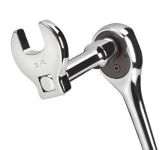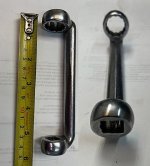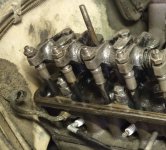Thanks to a rotted-out freeze plug, I have the "opportunity" to yank the head off my I8. (Darn the luck). Have ordered a FelPro gasket kit. Starting to work through all the steps in my head.
It's not all a wasted effort. I have a few lifters that could use inspection. One was initially reluctant to pump up. Two of them rotate very lazily. One has seemingly taken a "set" and doesn't want to spin at all - with the engine running you manually spin that pushrod a quarter-turn, and can then watch that pushrod somewhat deliberately return to its previous position. Is that pushrod bent? Lifter worn concave? Guide hole and lifter varnished so that's the way it "wants" to sit? Unsure. I'm suspicious of option #1. Will be able to see what's what once the rockers are off. And I'll have the opportunity to at least "clean" or "flush" the lifters - need to see what the best approach would be. I don't necessarily want to disassemble any lifters, but that's not off the table, either, depending on how they look/behave.
My initial thought was: Just pull the head. Leave the (delicate, probably horribly rusted and siezed) manifolds attached. Best not to touch anything I don't NEED to touch, that can start a slippery slope. Replace the freeze plug in the head, replace all 4 block freeze plugs, reinstall the head, the end.
But of course, once the head's off, there are more "opportunities".
Pull valve springs, inspect, lap the valves into the seats. Inspect guides & valvestems. (I don't have a reamer so I *really* hope the guides are all good!) That PROBABLY makes sense.
I'm pretty sure my heat riser is stuck open ("full heat"), might be able to do more from the *inside* than from the outside. Been juicing and tapping for weeks, it's still seized hard. Being able to manipulate it from the inside could help. So MAYBE that's something I should tackle with the unit on the bench. If nothing else, applying a little "blue wrench" (torch) from the inside as well as the outside couldn't hurt.
Then there's the stuff that scares me. If I pulled the manifolds I could have the head mating surfaces trued. I have one manifold stud (frontmost) that's snapped off inside the head, could get that addressed. All of that "could" make things better. Alternatively, all of that "could" end up breaking what is currently a perfectly good manifold. I don't believe I NOW have any head sealing issues - I will of course apply a straightedge and inspect judiciously - so I'm currently of the opinion of "if it's not broken now, don't break it trying to fix it."
Looking for opinions/validation/guidance based on your guys' experience. Am I being penny wise and pound foolish? I don't want to do damage to things unnecessarily - but I also don't want to pull the head again after discovering that the new gasket doesn't seal and have to go through all this pain ANYWAY.
It's not all a wasted effort. I have a few lifters that could use inspection. One was initially reluctant to pump up. Two of them rotate very lazily. One has seemingly taken a "set" and doesn't want to spin at all - with the engine running you manually spin that pushrod a quarter-turn, and can then watch that pushrod somewhat deliberately return to its previous position. Is that pushrod bent? Lifter worn concave? Guide hole and lifter varnished so that's the way it "wants" to sit? Unsure. I'm suspicious of option #1. Will be able to see what's what once the rockers are off. And I'll have the opportunity to at least "clean" or "flush" the lifters - need to see what the best approach would be. I don't necessarily want to disassemble any lifters, but that's not off the table, either, depending on how they look/behave.
My initial thought was: Just pull the head. Leave the (delicate, probably horribly rusted and siezed) manifolds attached. Best not to touch anything I don't NEED to touch, that can start a slippery slope. Replace the freeze plug in the head, replace all 4 block freeze plugs, reinstall the head, the end.
But of course, once the head's off, there are more "opportunities".
Pull valve springs, inspect, lap the valves into the seats. Inspect guides & valvestems. (I don't have a reamer so I *really* hope the guides are all good!) That PROBABLY makes sense.
I'm pretty sure my heat riser is stuck open ("full heat"), might be able to do more from the *inside* than from the outside. Been juicing and tapping for weeks, it's still seized hard. Being able to manipulate it from the inside could help. So MAYBE that's something I should tackle with the unit on the bench. If nothing else, applying a little "blue wrench" (torch) from the inside as well as the outside couldn't hurt.
Then there's the stuff that scares me. If I pulled the manifolds I could have the head mating surfaces trued. I have one manifold stud (frontmost) that's snapped off inside the head, could get that addressed. All of that "could" make things better. Alternatively, all of that "could" end up breaking what is currently a perfectly good manifold. I don't believe I NOW have any head sealing issues - I will of course apply a straightedge and inspect judiciously - so I'm currently of the opinion of "if it's not broken now, don't break it trying to fix it."
Looking for opinions/validation/guidance based on your guys' experience. Am I being penny wise and pound foolish? I don't want to do damage to things unnecessarily - but I also don't want to pull the head again after discovering that the new gasket doesn't seal and have to go through all this pain ANYWAY.




